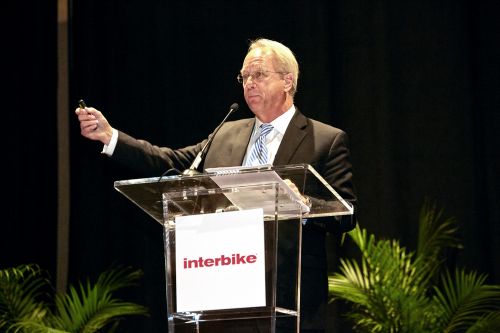LAS VEGAS (BRAIN) — Brian Payne, CEO of the Central Indiana Community Foundation, began his keynote at the Industry Breakfast lamenting that Indianapolis wasn't chosen as the venue for Interbike next year.
But, "I do want to congratulate you on Reno-Tahoe," he added.
Still, the transformation that Indianapolis has seen in recent years, since the eight-mile Cultural Trail opened in downtown, has prompted PeopleForBikes to move its new conference there. The PlacesForBikes conference in 2018 will take place in Indianapolis, Tim Blumenthal announced at the breakfast. The inaugural PFB conference took place in Madison, Wisconsin, this year.
Payne, who was the mastermind behind the Cultural Trail, said the $63 million bike path has changed Indianapolis, bicycling and him, personally.
"I was not a bicyclist, I was a community development person who found out about bikes through the Cultural Trail. Now between my wife and I we each have a road bike, a hybrid, and I just got an e-bike. I know she will demand an e-bike in three months," Payne said, laughing. "The trail creates bicyclists. The bicyclists did not create the trail."
Payne said he hoped to inspire other cities and towns to take action and build infrastructure, and noted how the trail has revitalized the downtown businesses within steps of it as well as bike dealers in town, who have seen an increase in cycling since the trail went in.
The Cultural Trail's name stems from the fact that it serves as a connector to all of the cultural districts in downtown. The idea was born in 2001. The mayor of Indianapolis had made it a goal of his to highlight Indianapolis as a cultural center. The trail was originally a five-mile project. But it ended up being eight miles that not only connects the cultural districts but four other major greenway trails.
"It's the downtown hub of our entire Central Indiana bike network – it connects to every arts, cultural, heritage, sports and entertainment venue in a very vibrant downtown," Payne said.
Payne was quick to note that before the trail went in, Indianapolis had no bike culture. And bicycling was unsafe.
"No one was biking to school. We are the Indy 500 city. We were about cars and going fast. So we had to change the culture," Payne said.
It was critical that the Cultural Trail provide the highest safety, so it has a four-foot buffer from cars, a pedestrian walkway and an 8-foot bike path. "Making it beautifully designed with beautiful landscaping, that's a game-changer," Payne noted.
The Cultural Trail met with some initial skepticism and was caught in some political battle early on. So while the idea was born in 2001, the mayor didn't greenlight it until 2005. The first half mile was built in 2007, and the last mile was completed in 2012, just in time for hosting the Super Bowl.
Still, the city said building it was the most difficult and challenging project it has ever taken on because it was eight miles through a busy commercial corridor.
According to Payne, a recent study found that from 2008 to 2013, property values increased within 500 feet from the trail about 170 percent or $1 billion as the Great Recession took hold and as commercial real estate in the rest of town remained flat, he said.
The Cultural Trail has spurred over a billion dollars of new development including mixed-used apartments, condos and boutique hotels, Payne noted.
About half of the trail's users take it to get to their destination while the other half use it because it's just a fun way to get through downtown.
Payne said cities looking to expand their infrastructure should emphasize the economic development that these trails spur.
"Tie it into things other people think are priorities," he said. "The great thing of bicycling infrastructure is it creates a better life and environment, more sense of community.
"Bicycling and bike infrastructure ties into everything that's good. And that's how you sell it," he added.
Indianapolis has $100 million slated for new bike infrastructure over the next five to 10 years as part of a re-envisioning of personal transportation, which Payne said will include the city's bike share, new bus and rapid transit, Lyft and other services, all tied into the smartphone so you can plan your daily commutes.
"We want to build a personal mobility network," Payne said.


